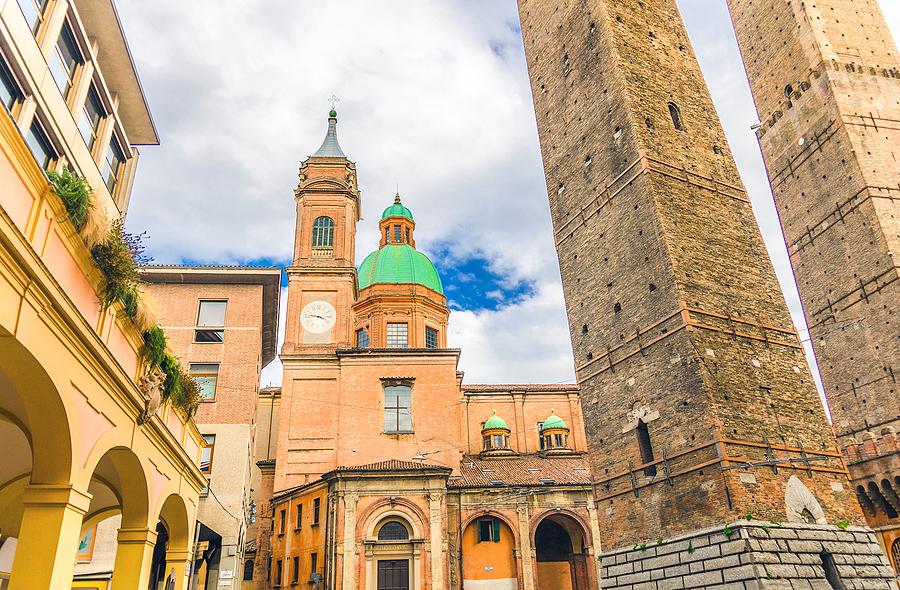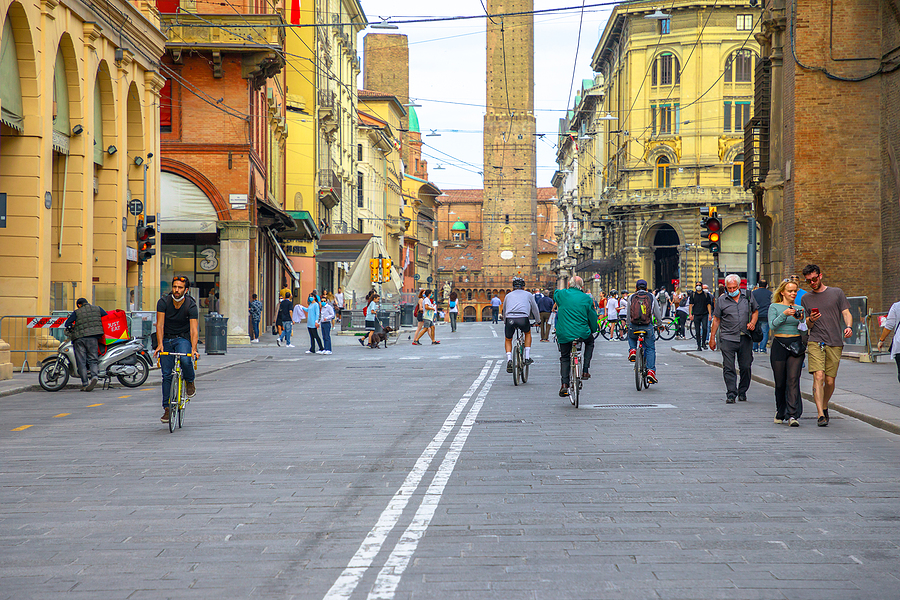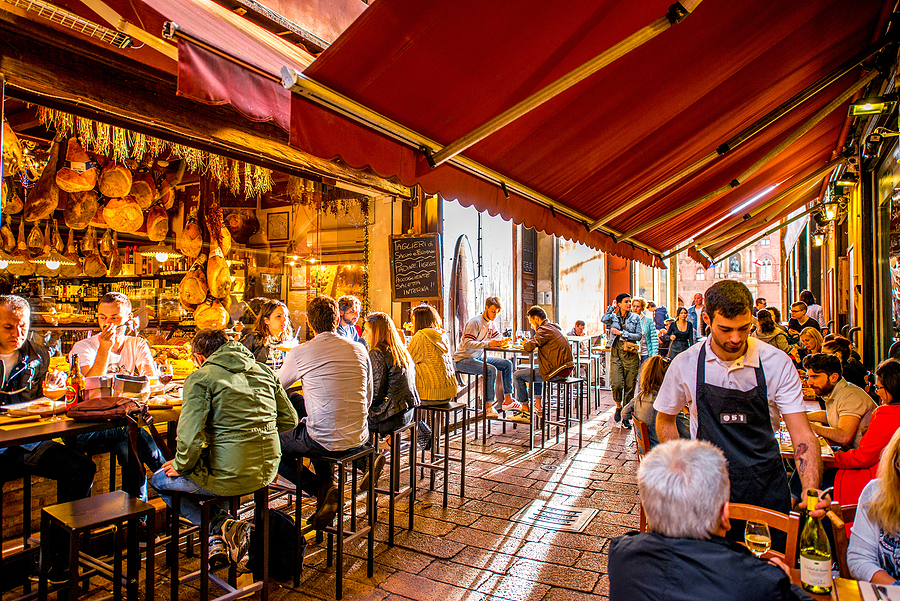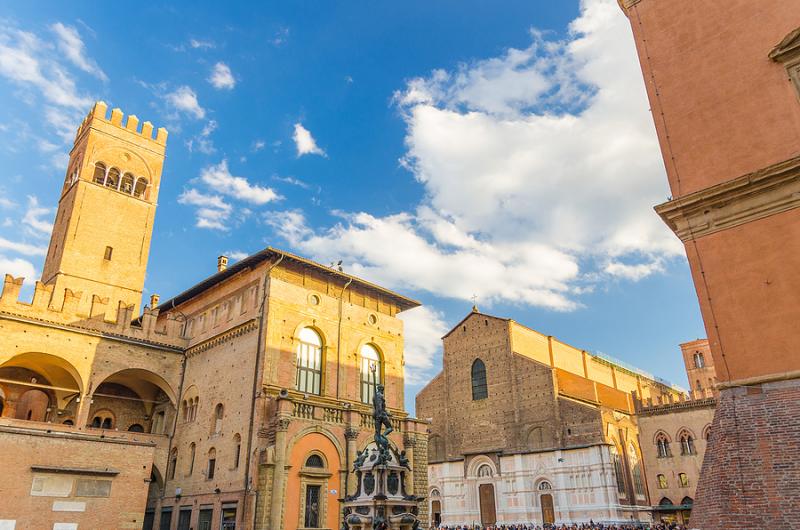Last week, I returned to Bologna’s historic center for the first time since the end of February. Bologna is my hometown and I live in the suburbs and, in normal times, I may go to the center once a week or, in normal tourist season, more often to run my tours. In normal times, it’s a regular experience I don’t give much thought to; in Covid times, it becomes an event to write about.
Perhaps because in Italy we went through one of the strictest lockdowns in the world, and perhaps because Italian media keeps pounding on us an alarmist tone, but for now at least, I no longer take for granted even something as trivial as going to the city center; you never know when it may be taken away from you. (During lockdown, for about two months, we were allowed to go out only to reach our workplace, go grocery shopping, to the pharmacy, or to medical visits).
Perhaps also because going out for whatever reason now requires an extra effort: remember to wear your mask! Wash your hands! Sanitize your hands when you enter a shop! Sanitize them again when you exit it! Don’t touch your face! Keep your distance! Don’t shake hands! Don’t kiss on the cheeks! (What has life come to.)
And perhaps for me it was even more of an event because, for most of 2020, I haven’t been in Bologna. I moved to a tiny mountain village in Trentino (northern Italy) on March 1, without knowing a week later I’d be ‘locked down’ up there, all alone. On one hand, it felt safer because there were so few people around; on the other hand, it felt very isolating as my only personal interactions were with the cashier at the supermarket and with the pharmacist for all my anxiety-related ailments (covid-induced, if you can relate).

I was not able to return to Bologna until early June, when I could finally see my family again. On that occasion, I rarely went much farther than my neighborhood, and I saw my friends mostly at their houses or outside, when we would go on hikes together. I still didn’t feel comfortable going out to restaurants, nor going to the city center, which for me requires taking a bus; besides, I didn’t want to be around too many people, and Bologna’s city center normally has plenty of them (a friend of mine who once visited from out of town was stunned by how many people were out in the streets. And he lives in New York.). I left after ten days without experiencing much of the city and returned to the mountains, where I spent the entire summer.
I returned to Bologna again a few days before mid-September. This time, I engaged in more social activities. One of the first things I did was go eat a favorite dish of mine, crescentine (sort of a fried bread you eat with cold cuts and cheeses) in a trattoria up in the hills. Al fresco dining, of course. The place was full and the atmosphere was cheerful. Patrons seemed to enjoy their night out (truth be told, every time I go out I don’t perceive that sense of alarm you get every time you turn the TV on. Perhaps it's a sign: turn the TV off. Read a book instead.).
Then one morning I took an almost empty bus and headed to Bologna’s centro storico.

So what was it like to be in Bologna’s usually lively historic center again?
Piazza Maggiore, the heart of town, the place where the Bolognesi meet, was not the usual hustle and bustle. The outdoor tables of the cafés overlooking the piazza were mostly empty - it’s especially tourists who sit there and there were no tourists; we Bolognesi sit on the opposite side of the piazza, on the steps of the staircase that leads up to the Basilica of San Petronio, Bologna’s beloved main church, but those were empty too. There were a Carabinieri police car and a military truck stationed by the staircase instead.
Bologna has always had a vibrant historic center. Part of its dynamism is due to the University of Bologna, which enrolls more than 80,000 students coming from all over Italy every year, and about 3,000 exchange students from abroad. When I strolled through the city center in September, the university year hadn’t started yet, so I’m sure this was another reason for the center being quieter than usual.
The first thing I noticed was that there were only locals around. Bologna has become a popular tourist destination just in recent years, and September is usually one of the busiest months, so I had become used to seeing many visitors walking around, going on tours, enjoying the famous local food. But this September, walking around the city center, it felt like I was in the Bologna of ten years ago…when the joke was that Bologna was just a stop on the train between Venice and Florence - and nobody got off.
Bologna was never a city for tourists and that was part of its appeal for the few who did come. In our city center, you could see the Bolognesi socializing, eating, shopping, and going about their daily lives.
You still do, but you also begin to see some changes. The Quadrilatero area, site of a centuries-old open-air market, has become overrun with tourists, who fill the numerous eateries offering the same standard tagliere (platter of cured meats and cheeses) that have popped up in recent years.

While we are far from the numbers of other cities ‘stars’, like Florence (12 million tourists a year) and Venice (20 million) - Bologna gets less than three million - discussions on the perils of mass tourism have been taking place in Bologna too. Some for example lament the increasing number of apartments transformed into Airbnbs, which push the residents out, or the growth of low-quality eateries and international chains over independent shops.
Is this the fate of all tourist destinations? We shall see what happens in Bologna. While the local tourism boards strive to promote the city in all its facets, it is a fact that Bologna has become to be known as 'the city of food.' Yes, it does have great culinary traditions, but when you encapsulate a city in just one box, you flatten the experience.
Many lament the economic losses of the travel industry, one of the worst-hit by the pandemic. But, if in the middle of difficulty lies opportunity, as a certain scientist said, perhaps this moment in history can be used to find new approaches to tourism. For example, instead of rushing to subsidize airlines and cruise lines, incidentally some of the worst polluters, governments could support local projects and companies that are careful about their impact on the environment. And travelers could take one less international trip to focus instead on a destination closer to home.
As I pondered these thoughts, I headed back to the bus stop to go home. I skipped the first that came because it was too crowded (something I did pre-covid too). Perhaps next time I return to the city center it won’t feel like a special event. But I think it will be a while before I return. I am back in the peace and solitude of my mountain village, and I love it.



